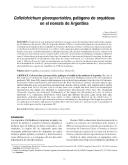Mostrar el registro sencillo del ítem
Colletotrichum gloeosporioides, patógeno de orquídeas en el noreste de Argentina
| dc.contributor.author | Cabrera, M.G. | |
| dc.contributor.author | Galmarini, M.R. | |
| dc.contributor.author | Flachsland, E. | |
| dc.date.accessioned | 2015-03-19T21:05:45Z | |
| dc.date.available | 2015-03-19T21:05:45Z | |
| dc.date.issued | 2003 | |
| dc.identifier | 466671 | es_ES |
| dc.identifier.issn | 1659-0082 | es_ES |
| dc.identifier.uri | https://repositorio.catie.ac.cr/handle/11554/5898 | |
| dc.description | 4 ilus. 10 ref. | es_ES |
| dc.description.abstract | El objetivo de este trabajo fue identificar el agente causal de manchas foliares detectadas en plantas Orchidaceae del noreste (NE) de Argentina. Desde el 2001, se recolectaron muestras con síntomas de enfermedad en invernaderos de las ciudades de Corrientes, Resistencia (Chaco) y Formosa, y muestras procedentes de Esteros de Iberá (Corrientes). Los cultivos sobre agar-papa-glucosa produjeron abundantes colonias de micelio aéreo gris y conidios unicelulares, oblongos, hialinos, con extremos redondeados de 16,0 a 24,0 ¿m x 4,0 a 6,0 ¿m. Las setas fueron rectas y oscuras. Sobre la base de características morfológicas, el hongo se identificó como Colletotrichum gloeosporioides Penz. Sacc. Se manifestó el teleomorfo Glomerella cingulata. Se determinó la patogenicidad de un aislamiento sobre hojas de Cattleya intermedia x C. walkeriana, Dendrobium nobile Lind. y Miltonia flavescens Lind. en inoculaciones con heridas, y se observaron síntomas una semana después de la inoculación. Se reaisló a C. gloeosporioides como patógeno. Este es el primer informe de C. gloeosporioides afectando diversas especies de orquídeas en el NE de Argentina. The aim of this study was to identify the causal agent of leaf spots detected in Orchidaceae plants from the Argentinian northeast (NE). Since 2001, samples with symptoms were collected in greenhouses from the cities of Corrientes, Resistencia (Chaco) and Formosa, and from Esteros del Iberá (Corrientes). Cultures on potato-glucose-agar yielded abundant, gray aerial mycelium and unicellular, hyaline, oblong conidia, with rounded ends. Conidial size ranged from 16.0 to 24.0 ¿m x 4.0 to 6.0 ¿m. Setae were straight and dark. Based on morphological characteristics, the fungus was identified as Colletotrichum gloeosporioides Penz. Sacc. The teleomorph Glomerella cingulata was developed. Pathogenicity of the fungus was determined on leaves of Cattleya intermedia x C. walkeriana, Dendrobium nobile Lind. and Miltonia flavescens Lind. Seven days after inoculation, symptoms appeared that were similar to those originally observed on the orchid leaves. C. gloeosporioides was isolated again from infected leaves, confirming it as the pathogen. The fungus was reported as a pathogen on 19 genera and species of orchids. This is the first report of C. gloeosporioides as a pathogen of several orchid species in the Argentinian NE. | es_ES |
| dc.language.iso | es | es_ES |
| dc.publisher | CATIE, Turrialba (Costa Rica) | es_ES |
| dc.subject | ORCHIDACEAE | es_ES |
| dc.subject | GLOMERELLA CINGULATA | |
| dc.subject | HOJAS | |
| dc.subject | ORGANISMOS PATOGENOS | |
| dc.subject | SINTOMAS | |
| dc.subject | MANCHAS | |
| dc.subject | ENFERMEDADES DE LAS PLANTAS | |
| dc.subject | PATOGENICIDAD | |
| dc.subject | ARGENTINA | |
| dc.title | Colletotrichum gloeosporioides, patógeno de orquídeas en el noreste de Argentina | es_ES |
| dc.title.alternative | Colletotrichum gloeosporioides, pathogen of orchids in the northeast of Argentina | es_ES |
| dc.type | Artículo | es_ES |
Ficheros en el ítem
Este ítem aparece en la(s) siguiente(s) colección(ones)
-
Publicaciones y documentos [4419]


